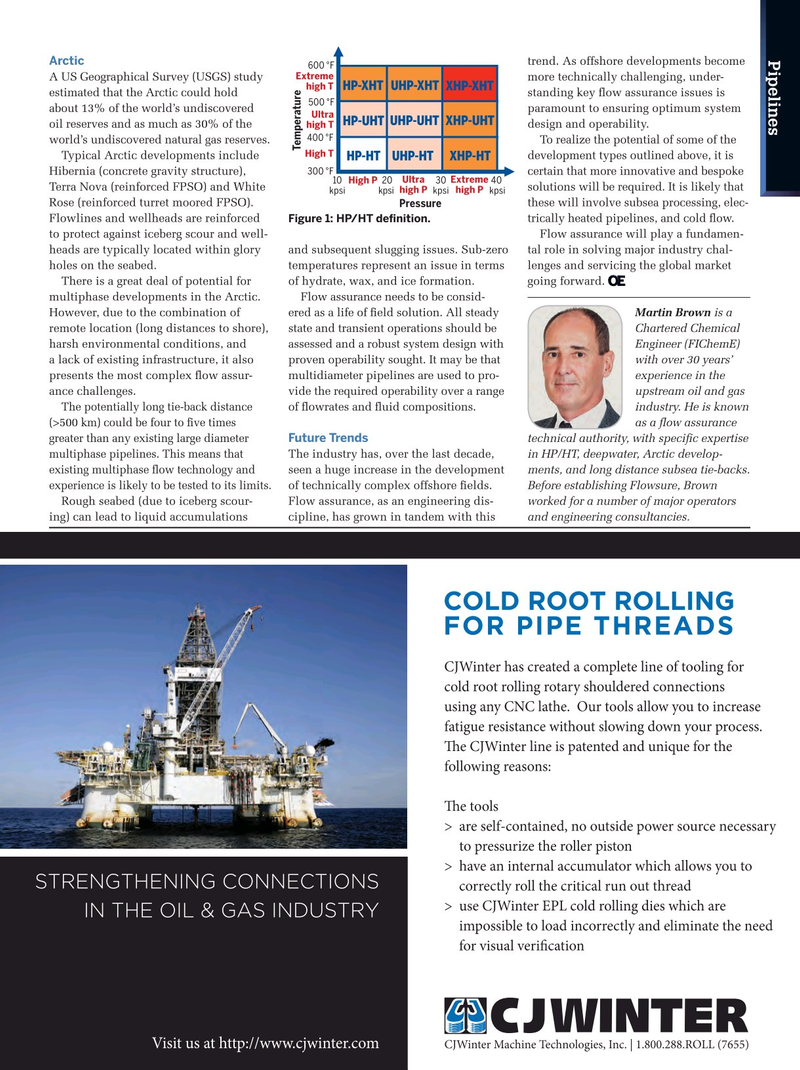
Page 55: of Offshore Engineer Magazine (Jul/Aug 2014)
Read this page in Pdf, Flash or Html5 edition of Jul/Aug 2014 Offshore Engineer Magazine
Pipelines trend. As offshore developments become
Arctic 600 °F
Extreme
A US Geographical Survey (USGS) study more technically challenging, under- high T
HP-XHT UHP-XHT XHP-XHT estimated that the Arctic could hold standing key fow assurance issues is 500 °F about 13% of the world’s undiscovered paramount to ensuring optimum system
Ultra
HP-UHT UHP-UHT XHP-UHT oil reserves and as much as 30% of the design and operability. high T 400 °F world’s undiscovered natural gas reserves. To realize the potential of some of the
Temperature
High T
Typical Arctic developments include development types outlined above, it is
HP-HT UHP-HT XHP-HT 300 °F 10 20 30 40
Hibernia (concrete gravity structure), certain that more innovative and bespoke
High P Ultra Extreme
Terra Nova (reinforced FPSO) and White solutions will be required. It is likely that high P high P kpsi kpsi kpsi kpsi
Rose (reinforced turret moored FPSO). these will involve subsea processing, elec-
Pressure
Flowlines and wellheads are reinforced trically heated pipelines, and cold fow.
Figure 1: HP/HT defnition.
to protect against iceberg scour and well- Flow assurance will play a fundamen- heads are typically located within glory and subsequent slugging issues. Sub-zero tal role in solving major industry chal- holes on the seabed. temperatures represent an issue in terms lenges and servicing the global market
There is a great deal of potential for of hydrate, wax, and ice formation. going forward. multiphase developments in the Arctic. Flow assurance needs to be consid-
However, due to the combination of ered as a life of feld solution. All steady Martin Brown is a remote location (long distances to shore), state and transient operations should be Chartered Chemical harsh environmental conditions, and assessed and a robust system design with Engineer (FIChemE) a lack of existing infrastructure, it also proven operability sought. It may be that with over 30 years’ presents the most complex fow assur- multidiameter pipelines are used to pro- experience in the ance challenges. vide the required operability over a range upstream oil and gas
The potentially long tie-back distance of fowrates and fuid compositions. industry. He is known (>500 km) could be four to fve times as a fow assurance
Future Trends greater than any existing large diameter technical authority, with specifc expertise
The industry has, over the last decade, in HP/HT, deepwater, Arctic develop- multiphase pipelines. This means that seen a huge increase in the development ments, and long distance subsea tie-backs. existing multiphase fow technology and of technically complex offshore felds. Before establishing Flowsure, Brown experience is likely to be tested to its limits.
Rough seabed (due to iceberg scour- Flow assurance, as an engineering dis- worked for a number of major operators ing) can lead to liquid accumulations cipline, has grown in tandem with this and engineering consultancies.
054_OE0714_Pipelines-3.indd 57 6/20/14 7:14 PM

 54
54

 56
56